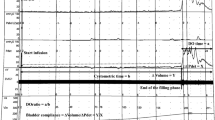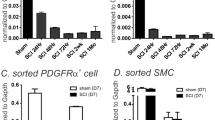Abstract
Introduction: Parathyroid hormone-related protein (PTHrP), in addition to the well-established role in endochrondral bone development, is believed to be an important mediator of cellular growth and differentiation in a number of non-bony tissues. Objectives: To compare the immunohistochemical staining of vesical transitional epithelium to antibodies raised to synthetic peptides of PTHrP composed of amino acid sequences 43–52 and 127–138 in patients with spinal cord injury (SCI) and neuropathic bladder (n=14), and control patients with intact neuraxis and no history of bladder cancer (n=10). Setting: Male SCI patients registered with Regional Spinal Injuries Centre, Southport, England. Intervention: Endoscopic cold cup biopsy from the trigone of the urinary bladder was taken from patients with SCI while they were undergoing a therapeutic procedure in the urinary bladder. The control samples of bladder biopsies were taken from the archives of the Department of Histopathology, District General Hospital, Southport. Immunohistochemistry was performed using rabbit antibodies raised against synthetic peptides of human PTHrP (43–52) and PTHrP (127–138). The biopsies were examined for immunostaining of transitional epithelium. Results: Of the 14 biopsies of SCI patients, positive immunostaining using antibodies to both the PTHrP peptides was found in four cases; five biopsies showed positive immunostaining only to anti-PTHrP (43–52); and five biopsies showed no immunostaining with either of the PTHrP peptides. In contrast, transitional epithelium in the biopsy specimens of ten control subjects with no history of bladder cancer showed no immunostaining with either of the PTHrP peptides. Conclusion: This study revealed that the transitional epithelium of neuropathic urinary bladder exhibits increased predilection for positive immunohistochemical staining for PTHrP (43–52), and to a lesser extent, to PTHrP (127–138), as compared to the vesical transitional epithelium of able bodied individuals with no history of vesical malignancy. The possible role of PTHrP in the cellular differentiation of urothelium of neuropathic bladder, and thereby, in the pathogenesis of cystitis in SCI patients, needs to be explored.
Similar content being viewed by others
Log in or create a free account to read this content
Gain free access to this article, as well as selected content from this journal and more on nature.com
or
Author information
Authors and Affiliations
Rights and permissions
About this article
Cite this article
Vaidyanathan, S., McCreavy, D., McDicken, I. et al. Immunohistochemical study of parathyroid hormone-related protein in vesical transitional epithelium of patients with spinal cord injury. Spinal Cord 37, 760–764 (1999). https://doi.org/10.1038/sj.sc.3100921
Published:
Issue date:
DOI: https://doi.org/10.1038/sj.sc.3100921
Keywords
This article is cited by
-
Nanowired Delivery of Growth Hormone Attenuates Pathophysiology of Spinal Cord Injury and Enhances Insulin-Like Growth Factor-1 Concentration in the Plasma and the Spinal Cord
Molecular Neurobiology (2015)
-
Expression of parathyroid hormone-related protein in the partially obstructed and reversed rabbit bladder
International Urology and Nephrology (2009)



